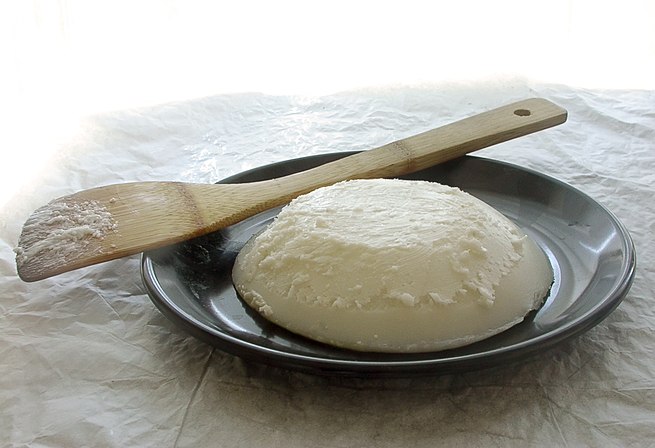Main Difference
The main difference between Lard and Butter is that the Lard is a pig fat in both its rendered and unrendered forms and Butter is a dairy product.
-
Lard
Lard is pig fat in both its rendered and unrendered forms. It is obtained from any part of the pig where there is a high proportion of adipose tissue. It can be rendered by steaming it or boiling it in water and then separating the insoluble fat from the water, or by the use of dry heat. It is a semi-soft white fat with a high saturated fatty acid content and no transfats. Refined lard is usually sold as paper-wrapped blocks.
Lard is commonly used in many cuisines around the world as a cooking fat or shortening, or as a spread similar to butter. It is an ingredient in various savoury dishes such as sausages, pâtés and fillings, and it is particularly favored for the preparation of pastry because of the “flakiness” it brings to the product. Its use in western contemporary cuisine has diminished with the increased popularity of vegetable oils, but many contemporary cooks and bakers still favor it over other fats for certain select uses. The culinary qualities of lard vary somewhat depending on the part of the pig from which the fat has been taken, and how the lard is processed.
-
Butter
Butter is a dairy product containing up to 80% butterfat (in commercial products) which is solid when chilled and at room temperature in some regions and liquid when warmed. It is made by churning fresh or fermented cream or milk to separate the butterfat from the buttermilk. It is generally used as a spread on plain or toasted bread products and a condiment on cooked vegetables, as well as in cooking, such as baking, sauce making, and pan frying. Butter consists of butterfat, milk proteins and water, and in some types, added salt. Butter may also be sold with added flavourings, such as garlic butter.
Most frequently made from cows’ milk, butter can also be manufactured from the milk of other mammals, including sheep, goats, buffalo, and yaks. Salt such as dairy salt, flavorings and preservatives are sometimes added to butter. Rendering butter produces clarified butter or ghee, which is almost entirely butterfat.
Butter is a water-in-oil emulsion resulting from an inversion of the cream; in a water-in-oil emulsion, the milk proteins are the emulsifiers. Butter remains a solid when refrigerated, but softens to a spreadable consistency at room temperature, and melts to a thin liquid consistency at 32–35 °C (90–95 °F). The density of butter is 911 g/L (0.950 lb per US pint). It generally has a pale yellow color, but varies from deep yellow to nearly white. Its unmodified color is dependent on the animals’ feed and genetics but is commonly manipulated with food colorings in the commercial manufacturing process, most commonly annatto or carotene.
-
Lard (noun)
Fat from the abdomen of a pig, especially as prepared for use in cooking or pharmacy.
-
Lard (noun)
Fatty meat from a pig; bacon, pork.
-
Lard (verb)
To stuff (meat) with bacon or pork before cooking.
-
Lard (verb)
To smear with fat or lard.
-
Lard (verb)
To garnish or strew, especially with reference to words or phrases in speech and writing.
-
Lard (verb)
To fatten; to enrich.
-
Lard (verb)
To grow fat.
-
Lard (verb)
To mix or garnish with something, as by way of improvement; to interlard.
-
Butter (noun)
A soft, fatty foodstuff made by churning the cream of milk (generally cow’s milk).
-
Butter (noun)
Any of various foodstuffs made from other foods or oils, similar in consistency to, eaten like or intended as a substitute for butter (preceded by the name of the food used to make it).
“peanut butter”
-
Butter (noun)
Any specific soft substance.
“butter of antimony; butter of arsenic”
-
Butter (noun)
Someone who butts in.
-
Butter (verb)
To spread butter on.
“Butter the toast.”
-
Butter (verb)
To move one’s weight backwards or forwards onto the tips or tails of one’s skis or snowboard so only the tip or tail is in contact with the snow.
-
Butter (verb)
To increase (stakes) at every throw of dice, or every game.
-
Lard (noun)
fat from the abdomen of a pig that is rendered and clarified for use in cooking.
-
Lard (noun)
excess fat in a person
“I’ve got to give up fags and shift some lard”
“he’s just a tub of lard”
-
Lard (verb)
insert strips of fat or bacon in (meat) before cooking
“he larded the joint with garlic and anchovies”
-
Lard (verb)
smear or cover (a foodstuff) with lard or fat to prevent it drying out during storage
“farmhouse cheeses are dipped in wax or larded”
-
Lard (verb)
embellish (talk or writing) with an excessive number of esoteric or technical expressions
“his conversation is larded with quotations from Coleridge”
-
Lard (verb)
cover or fill thickly or excessively
“the pages were larded with corrections and crossings-out”
-
Butter (noun)
a pale yellow edible fatty substance made by churning cream and used as a spread or in cooking.
-
Butter (verb)
spread (something) with butter
“Lily buttered a slice of toast”

